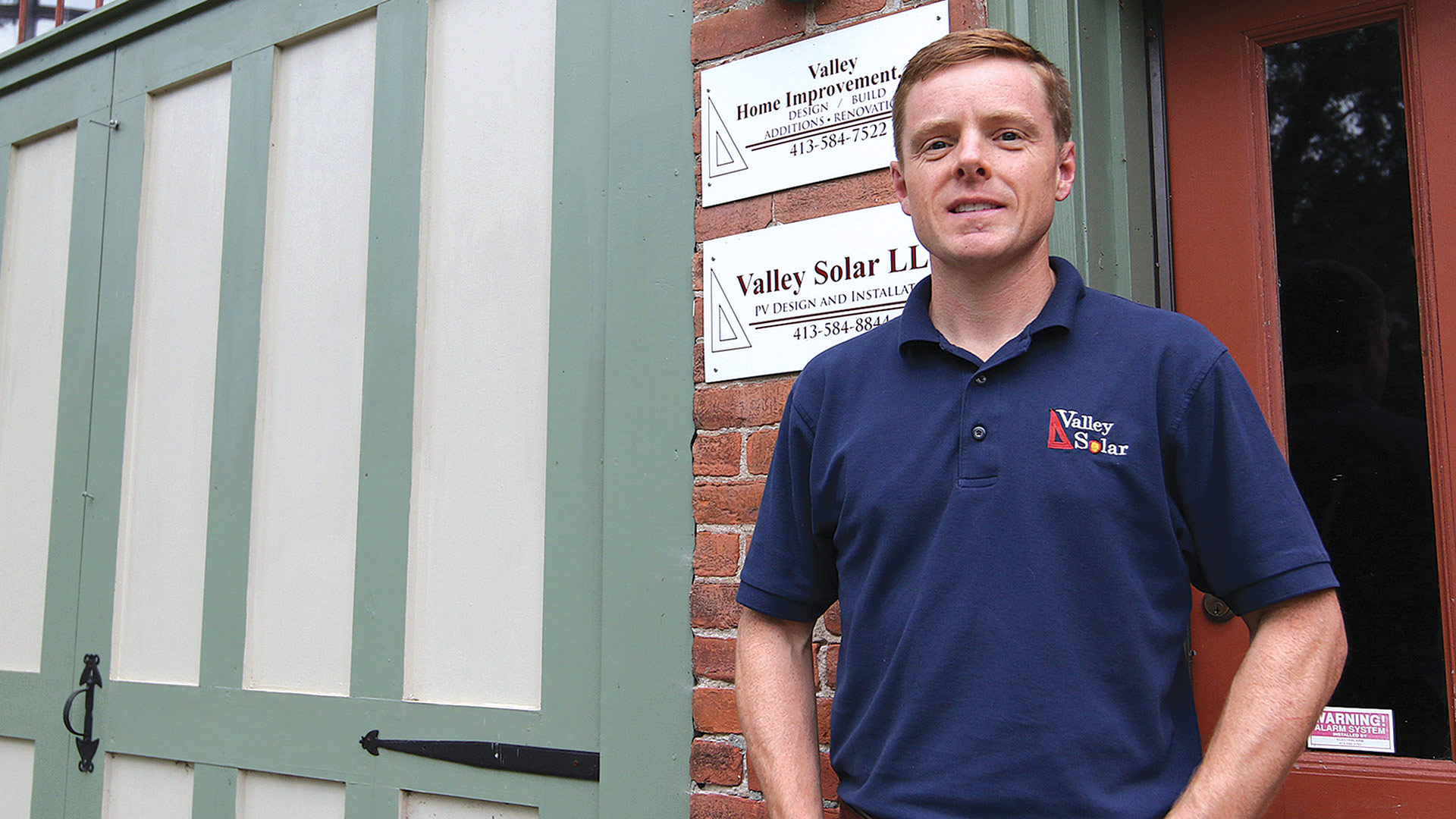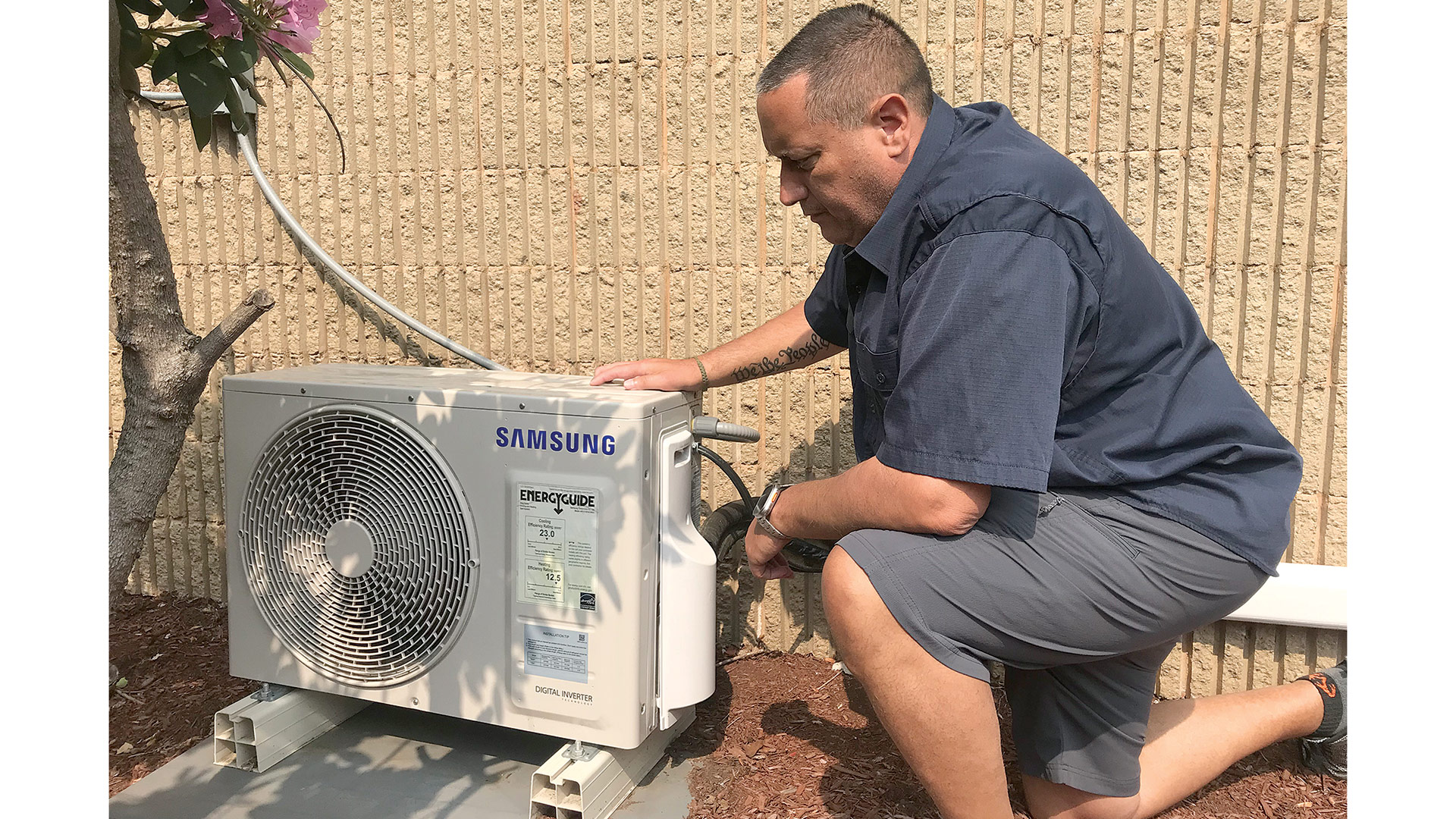
Homeowners Increasingly Seek Energy-efficient Technologies
Sustainable Solutions
By Mark Morris

Brian Rudd compares a traditional vinyl panel with an insulated one.
In the past year, energy prices have taken a bigger chunk out of everyone’s budget. Increases at the gas pump get the most attention, but rising costs for heating and cooling homes have also taken their toll on bank accounts.
That’s why, as homeowners look to renovate and update their spaces, energy efficiency is often top of mind.
As local contractors told BusinessWest, when homeowners build or invest in new projects, long-term energy savings have become a key consideration. The good news is that many home-improvement products today use technologies that deliver that energy savings better than ever before.
Brian Rudd, owner of Vista Home Improvement in West Springfield, explained that, when people consider vinyl siding, it’s an opportunity to make their house look good and create an insulation barrier that saves energy.
“The foam insulation that is behind the siding is amazing in the way it encapsulates the home,” he said. “The siding panel that faces out looks great and is designed to reflect the sun and slow down the transfer of energy, which keeps the house cooler in the summer and warmer in the winter.”
Rudd believes it’s important to stay on top of advances in materials and sees siding as more than a house covering; in fact, he considers siding installed 20 or 30 years ago “old technology.” Indeed, one industry statistic suggests that a proper siding job can increase energy efficiency on an average home up to 15%.
“There are advances happening in materials all the time, and we believe in staying on top of the latest technologies,” he added.
Another project that adds to aesthetics and energy efficiency is replacement windows. The Environmental Protection Agency notes that new windows can save energy and increase comfort. Like new siding, windows can also add to a home’s resale value.
“There’s nothing worse than having an attic that overheats in the summer and loses heat in the winter. Proper ventilation allows for better air flow, which contributes to a longer life for the roof and helps to better control a family’s energy costs.”
While Rudd said updating windows is always a good choice, he pointed out that it’s easy to forget about doors. “Most people with older doors have air leaks because, over time, doors shift out of place due to foundations moving from hot and cold temperatures over many years.
New doors are designed using newer technology and provide better insulation, he noted. “Some doors have self-leveling frames so they can adjust with changes in the seasons.”
Roofing technology also continues to advance as shingles are engineered with more reflective components. As important as the installation and materials, Rudd said the most effective energy savings with a new roof starts inside.

Patrick Rondeau says the rise in utility costs has driven demand for solar installations.
“We make sure there is proper ventilation in the attic space,” he said. “There’s nothing worse than having an attic that overheats in the summer and loses heat in the winter. Proper ventilation allows for better air flow, which contributes to a longer life for the roof and helps to better control a family’s energy costs.”
Here Comes the Sun
Due to international events and domestic refining issues, energy prices spiked across the board in 2022. While gasoline was a dollar higher at this time last year, it had a ripple effect on electric utility prices later in the year. At the two largest utilities in Massachusetts, National Grid raised its winter rates by 60%, and Eversource increased its rate by 30% in January.
Such increases have kept Patrick Rondeau busy. As general manager and co-owner of Valley Solar in Easthampton, he said the significant rise in utility rates has increased homeowner demand for solar-energy installations.
The cost to generate a kilowatt hour by solar averages between 7 and 14 cents over the life of the system. By contrast, winter utility rates were as high as 45 to 50 cents per kilowatt hour, he explained. “In an ideal scenario, a solar installation can produce 100% of the energy a person needs for their home.”
In many cases, in fact, solar installations can produce more than a homeowner currently needs. Rondeau encourages customers to build a system that will consider their future needs.
“In an ideal scenario, a solar installation can produce 100% of the energy a person needs for their home.”
“If someone is planning to buy an electric car, for example, their energy use will increase,” he said. “When people only look at today’s usage, they often come back two years later to see if they can add panels.”
Even if they don’t buy an electric car, Rondeau pointed out that energy use tends to increase after a solar installation because customers stop worrying about energy consumption. “It becomes a quality-of-life and comfort issue. The preoccupation with the thermostat setting goes away. I see it all the time.”
In Massachusetts, another advantage to generating more energy is net metering. When a homeowner’s solar panels generate more energy than needed, the excess energy can be sold back to the grid. As an example of how it works, Rondeau said a solar installation might produce 10,000 kilowatt hours each year, and 7,000 of those kilowatt hours might be produced during the five months of the year with the most sunshine.
“The homeowner will net meter a certain percentage of what they produce, which generates a credit on their electric bill,” he explained. “Then, in the winter months, when there are shorter, darker days, they use that credit. It’s essentially a wash.”
He further explained net metering with a familiar New England analogy. “It’s like squirrels socking away food for the winter. Instead of acorns, people are storing up credits on their electric bill.”
Some homes have limited roof or yard space to accommodate solar panels, so their systems might not generate 100% of the home’s energy needs. But Rondeau said going solar is still a worthwhile investment.

Josh Smith shows off an outdoor unit that powers a mini-split heat-pump system.
“Some people are concerned about only producing enough energy for half of their needs,” he noted. “If you could lock in even half of your energy consumption at 14 cents, why wouldn’t you do that?”
Pump It Up
People with solar units can save even more energy and money when they install a heat pump. Recent advances in electric-powered heat pumps are helping homeowners to save energy without sacrificing comfort. These units have the ability to heat and cool a home and work best as a supplement to whatever heating system is already in the home.
“For years, heat pumps were found primarily in the south and warmer regions,” said Josh Smith, service manager for Berkshire Heating & Air Conditioning in West Springfield. “In the last 10 years, the technology has improved their efficiency so much that they are now a good choice for places like New England.”
In the simplest terms, a heat pump works like a furnace in the winter to warm the home and like an air conditioner in the summer to cool the house two to three times more efficiently than a traditional furnace or air conditioner.
For homes with a natural-gas furnace and ductwork, the heat-pump unit resembles a traditional central air-conditioner compressor. For houses without ductwork, a differently designed heat-pump compressor connects to a series of units inside the house. These air-handling units are known as mini-splits and provide cooling and heating for each room. One heat-pump compressor can feed up to six mini-splits, each one managed by remote control.
“For example, if three people are in the house and they all have different comfort levels, they can keep each room at a different temperature,” Smith said. “People really like this because they can have true zone-control for their heating and cooling using one main source.”
The U.S. Department of Energy estimates that homeowners can save, on average, $1,000 per year by switching to a heat pump. Savings vary depending on the type of heating system in the home. For example, when a heat pump replaces an electric baseboard system, the savings can exceed $1,200.
By contrast, savings compared to a natural-gas furnace are a few hundred dollars. Making the switch from a natural-gas system is still encouraged because Massachusetts and other New England states have plans in place to significantly reduce the use of natural gas and other fossil fuels used for heating by the end of this decade.
“The states want more people to use electricity as their energy source,” Smith said, “and heat pumps are the most efficient form of electric heat.”
While heat pumps provide plenty of benefits as the main heating and cooling source, he went on, it’s smart to keep traditional heating systems in place as a supplement.
“I like having a backup source because we live in New England where every few years we get a long cold snap,” he said. “Heat pumps have a hard time keeping up when it’s really cold, so it’s good to have that backup source when you need it.”
Even as a supplemental source, today’s traditional heating systems are more efficient than units from 10 years ago.
“Everything in the heating and cooling universe is becoming more efficient,” Smith said. “Even new oil burners use less oil than in the past.”
What’s in Store?
The next big development in solar involves energy storage, an area Rondeau called an increasingly large part of his business. At the most basic level, storage means batteries to keep the excess energy generated from a solar installation.
New battery-storage units are available that can send energy back to the grid as well as store it for the homeowner. The state program Connected Solutions allows utilities to pull energy out of home-based batteries during the highest-demand times and then compensate the homeowner when there is less demand. It’s up to the individual how much energy they want to make available to the grid and how much they want to store.
“People who want to be off grid as much as possible can set up their storage so they can be self-sufficient to an extent without risking too much battery drain,” Rondeau said.
Because the cost of these sophisticated storage devices can be expensive, the state offers 0% loans from Mass Save.
The biggest benefit of energy storage is evident during power outages. With the batteries storing power, a home’s electric system can continue to work uninterrupted. Rondeau noted that stored energy can be more effective and less fussy than owning a backup generator.
“Generators need to be tested every month. When you need to use them, they are noisy, and you have to buy fuel for them,” he explained. “Also, there are no 0% loans available for generators.”
As technology allows home solar systems to perform more complex tasks, the user interface is becoming simpler.
“It’s like your smartphone,” he said. “What it’s doing in the background is complex, but what you are doing with your thumb is simple.”
Because new materials are coming to market all the time, it’s important for homeowners considering any of these projects to speak with a professional. The businesses we spoke with all offer free consultations to help people get a realistic idea of what will work for them.
“I suggest people do their research,” Rudd said, “and spend the extra time to make sure they are getting exactly what they want for their home.”




